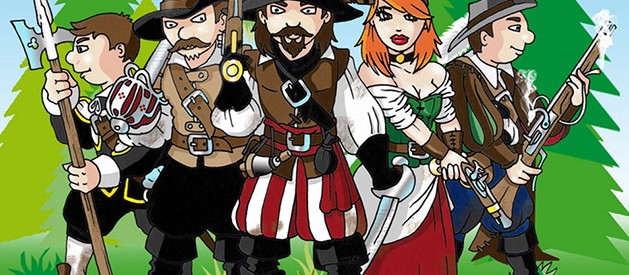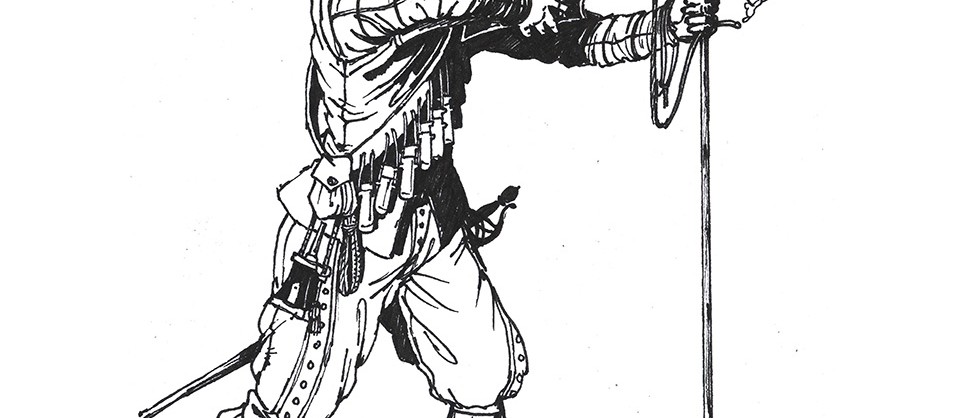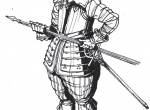
The educational journey of the robber Stetka
A nature trail around the surroundings of Štětí for the whole family, introducing the history and picturesque nature, industry and agriculture of Štetsko. The legendary robber Štětka and his four-member team are guiding the tour, giving information on a marked circuit starting from
In the old days of the Thirty Years' War, the robber Štětka was the master of the deep forests, fields and hillsides around the town of Štětí. Today, his home is the former Mordloch Cave, hidden away from people in the middle of the Stračen forests. Who knows him in the region. He protects the poor and honest, and justly punishes dishonesty and avarice. He has walked this land many times. He knows every road and footpath here.
During your adventurous journey with the robber Stetka you will come across educational boards that will tell you all about the history, nature, fauna and flora, industry and agriculture of the local region or visit the mythical cave Mordloch of the robber Stetka. You can also try out a discovery competition Following the footsteps of the robbers or robber geocaching.
Stops

Mordloch
ŠTĚTÍ DURING THE THIRTY YEARS' WAR
Population
Until the Thirty Years' War the population was two-thirds Czech. After the Battle of White Mountain, however, there was a strong Germanization. Germans from Úštěk were moved to the town. At the beginning of the war, however, the vast majority of names were still Czech, but already around 1625 many names mentioned in the records were German.
Town
The small town of Štětí belonged to the manor of Mělník and its owners used to be the holders of the Mělník pledge manor. In terms of area, the Baroque Štětí occupied a space that could be defined by Dlouhá Street, the bus station, the Elbe embankment and the Penny Market. It essentially copied its medieval model. In the 17th century, the town consisted of 72 houses, two of which were noble houses and a farmyard belonging to the municipality. The square used to be the centre of all the action.
City rights
Even though the town of Štětí was not particularly important, it had relatively large town rights. Most of the town's rights were claimed (acquired and reaffirmed) by Emperor Rudolf II in 1609. Apart from the market law, the town had the right of court and the right of throat; in front of the town hall there was a pillory with a gallows. On the so-called Gallows Hill on the road from Štětí to Čakovice there was a gallows, which in later times was a frequent cause of disputes with the authorities and with the town of Mělník. The executioners were hired either in Roudnice nad Labem or Mělník.
Crafts and trade
As far as crafts and trade are concerned, Štětí was mainly economic in the 17th century. The town owned a relatively large amount of agricultural land and its location in the fertile Elbe valley was favourable for agriculture. Rye, barley, wheat and legumes were grown in the surrounding fields, and vineyards were located on the slopes above the town, but these disappeared during the Thirty Years' War. The craftsmen, as in any other town, were associated in guilds. Among the crafts mentioned in Štětí are shoemakers, tailors, weavers, bakers, roofers, blacksmiths and coopers.
Parish church
We do not know the church that originally stood in Štětí. All we know is that on 11 November 1620 it was, like the whole town, completely plundered by Protestant mercenaries (several more times during the Thirty Years' War), and was therefore without a proper clergyman for a long time. It was not until 1626 that Count Vilém Slavata began to rebuild it. This "Slavata" church, which replaced the original church, was smaller than the present church. There was a rectory next to the church, which housed the parish school and a cemetery, which was closed in 1788 and moved to the premises of today's Bezručovy sady. The church originally had four bells.
War years
The defenestration of Prague on 23 May 1618 was the beginning of the Czech Estates Uprising and, in fact, the Thirty Years' War. Right at the beginning of the uprising in 1618, the estate of Mělník and thus the town of Štětí were given as a pledge to the knight Václav Felix Št'astný Pětipeský of Chyš, Bosyně, Obříství and Edenberga. After the suppression of the uprising, he was deprived of all his property and sentenced to life imprisonment. The Battle of Bílá Hora (8 November 1620) ended the Czech Estates Revolt and the time of revenge and confiscation began. The victorious Ligist army took cruel revenge on the participants of the uprising and ruthlessly plundered their estates. Already on the third day after the battle (11 November 1620) the Catholic League army came from Mělník through Liběchov and the town was plundered. In January 1621, Gen. Count Charles of Liechtenstein ordered the knight who commanded the garrison in Štětí to move to Litoměřice for the rest of the winter. The town escaped the post-Baroque confiscations and persecutions of the town's population, or no records of them have survived. Only two cases are known from Štětí.
In 1623 the Mělník manor and with it the town of Štětí were mortgaged to a prominent member of the Catholic nobility, Count William Slavat of Chlum and Košumberk, lord of Telč, Nová Bystřica and Mělník. In January of the same year, Prušek, the town clerk of Mělník, received from Hr. Lichtenstein, ordered to station another battalion of the imperial army under the command of Captain Taxis in the town of Mělník. According to the order, Taxis was to go with the army to Štětí. The question is whether he was really there, because he was already back in Melnik in March.
The city was badly damaged by the military campaigns, extortion and looting. In the old land register we can find records of the state of the town during this period. Some homesteads were completely ruined or burnt down, others were plundered and uninhabitable.
In 1631, Saxon troops under the command of Johann Georg Armin invaded Bohemia. The town was looted and plundered, the soldiers plundered the town treasury and stole the orphans' money. Further military invasions came between 1634 and 43. Due to the town's location on the strategically important road from Prague to the north, the town suffered frequent passages of troops from both warring sides. Moreover, in 1636 the town was hit by an exceptionally large flood, which badly affected it. The years 1645-48 were marked by constant Swedish offensives and imperial counter-offensives. Most of the Swedish invasions into Bohemia were directed from the north through Ústí nad Labem, Litoměřice, Mělník and thus also through Štětí further inland. The Thirty Years' War officially ended with the so-called "Peace of Westphalia" concluded in the cities of Münster and Osnabrück on 24 October 1648.


